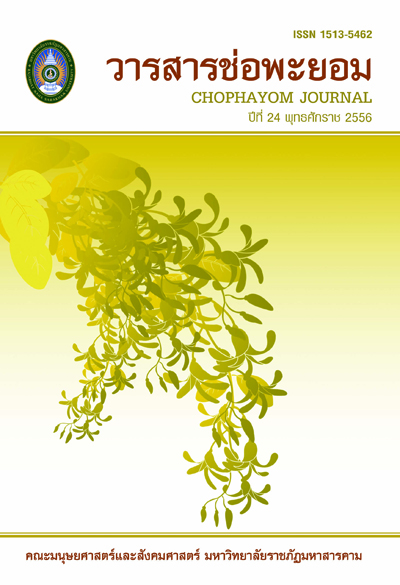กลวิธีการสร้างถ้อยคำรื่นหู ในภาษาไทยและภาษาจีนกลางปัจจุบัน Euphemism in Contemporary Thai and Mandarin Chinese
Abstract
บทคัดย่อมาจากถ้อยคำต้องห้ามในภาษาไทยและภาษาจีนกลางปัจจุบัน และเปรียบเทียบภาพสะท้อนในด้านความคิดความเชื่อ และค่านิยม จากถ้อยคำรื่นหูในภาษาไทยและภาษาจีนกลางปัจจุบัน ข้อมูลในการศึกษาได้จากถ้อยคำรื่นหูภาษาไทยที่ปรากฏในเว็บไซต์ www.pantip.com เก็บข้อมูลตั้งแต่ เดือนมีนาคมถึงเดือนมิถุนายน พ.ศ.2553 และภาษาจีนกลางปัจจุบันที่ปรากฏในเว็บไซต์www.dxju.com ตั้งแต่เดือนมีนาคมถึงเดือนมิถุนายน พ.ศ.2553 นำข้อมูลมาวิเคราะห์แบบเปรียบต่าง และนำเสนอผลการวิจัยด้วยวิธีพรรณาวิเคราะห์ ผลการวิจัยสรุปได้ดังนี้ 1) กลวิธีในการสร้างถ้อยคำรื่นหูมี 4 ประเภท คือ ประเภทดัดแปลงคำ ประเภทคำศัพท์ต่างประเทศ ประเภทลดความหมายของคำ และประเภทอุปลักษณ์ 2) ความหมายของถ้อยคำรื่นหูมี 2 ลักษณะ คือ ความหมายโดยตรงและความหมายโดยอ้อม 3) ภาพสะท้อนในด้านความคิดความเชื่อ และค่านิยมจากถ้อยคำรื่นหูในภาษาไทยและภาษาจีนกลางปัจจุบัน
ภาพสะท้อนด้านความคิดความเชื่อมีความสัมพันธ์กับถ้อยคำรื่นหูทั้งในภาษาไทยและภาษาจีนกลางปัจจุบัน เช่น คนไทยกับตัวเหี้ย คนไทยเชื่อว่าตัวเหี้ย เป็นสิ่งอัปมงคล ไม่ควรกล่าวถึง เพราะหากกล่าวถึงจะนำความอัปมงคล1 นิสิตระดับปริญญาโทสาขาภาษาและวรรณกรรมไทย – จีน มหาวิทยาลัยมหาสารคาม2 อาจารย์ประจำสาขาวิชาภาษาและวรรณกรรมไทย – จีน มหาวิทยาลัยมหาสารคามวารสารช่อพะยอมปีที่ 24 พุทธศักราช 2556 4และสิ่งชั่วร้ายมาสู่ตัวผู้พูดและผู้ฟัง จึงเลี่ยงโดยใช้คำว่า ตัวกินไก่ ตัวเห้ แทนส่วนคนจีนเชื่อว่า หากกล่าวถึงความตายโดยตรง จะนำพาสิ่งชั่วร้ายมาสู่ตัวผู้พูด เช่นเมื่อกล่าวถึงคำว่า ตาย จะเลี่ยงใช้คำว่า เสียชีวิต นอนสุสานปาเป่า แทนในด้านภาพสะท้อนค่านิยมมีความสัมพันธ์กับถ้อยคำรื่นหูทั้งในภาษาไทยและภาษาจีนกลางปัจจุบัน เช่น ค่านิยมของคนไทย มีค่านิยมในเรื่องความสุภาพอ่อนน้อม ไม่ว่าจะเป็นการกระทำและคำพูด เช่น เมื่อกล่าวถึง ตด จะเลี่ยงใช้คำว่า ผายลมแทน ส่วนค่านิยมของคนจีน มีค่านิยมในเรื่องความรํ่ารวย ความอุดมสมบูรณ์ เช่น หากกล่าวถึงความอ้วน จะเลี่ยงใช้คำว่า อุดมสมบูรณ์ แทน
โดยสรุป ผลจากการวิจัยนี้สามารถทำให้ทราบถึงกลวิธีการสร้างถ้อยคำรื่นหูของทั้งภาษาไทยและภาษาจีนกลางปัจจุบัน รวมทั้งได้เข้าใจความคิดความเชื่อ และค่านิยมของคนทั้งสองประเทศ ผ่านภาษาที่ใช้ในปัจจุบันได้อย่างถ่องแท้มากขึ้น
ABSTRACT
The thesis aimed at studying the strategies of euphemism creationsderived from Thai and contemporary Mandarin Chinese taboos andcomparing the refl ections in terms of thoughts, beliefs, and values fromthe two languages’ euphemisms. The Thai euphemisms in the websitecalled www.pantip.com were collected from March to June 2010. Thecontemporary Mandarin Chinese euphemisms appeared in www.dxju.com were also collected from March to June 2010. The collected datawere analyzed comparatively and contrastively. Descriptive analysis wasemployed to reveal the results of the study.
The results found could be concluded as follows: 1) There were4 types of strategies in euphemism creations, namely, modifi cation ofword, vocabulary of foreign languages, deterioration of word meaning,and metaphor; 2) There were two characteristics of the meanings ofeuphemisms – direct and indirect meanings; 3) There were refl ectionsof thoughts, beliefs, and values shown through Thai and contemporaryMandarin Chinese.
The refl ections of thoughts and beliefs were related to both Thaiand contemporary Mandarin Chinese euphemisms. Thai people believethat a water monitor (‘hia’ in Thai) was an inauspicious animal by its name,for example. People avoided mentioning its name and choose to call it a‘chicken eater’ and ‘hae’ instead. For Chinese people, they believed that ifmentioning the word ‘death’, it would bring bad lucks to the speaker. Thus,they chose to say ‘pass away’ and ‘sleep in Pa Pao graveyard’ insteadof the word ‘die’. The refl ections of values were also related to both Thaiand contemporary Mandarin Chinese euphemisms. For example, Thaipeople had values on politeness and humbleness in both actions andwords. They would avoid saying the word ‘fart’ but say ‘release the wind’instead. Chinese people had values on wealth and fertility. For example,when they refered to ‘fatness’, they would use the word ‘fertility’.
In conclusion, the results of the present study help to recognizethe strategies of euphemism creations in both Thai and contemporaryMandarin Chinese as well as truly understand the thoughts, beliefs, andvalues of both Thai and Chinese people through the uses of their presentlanguages.
Downloads
How to Cite
ศรีมันตะ ท. (2014). กลวิธีการสร้างถ้อยคำรื่นหู ในภาษาไทยและภาษาจีนกลางปัจจุบัน Euphemism in Contemporary Thai and Mandarin Chinese. Chophayom Journal, 24, 3–19. retrieved from https://so01.tci-thaijo.org/index.php/ejChophayom/article/view/15814
Issue
Section
บทความวิจัยทางด้านมนุษยศาสตร์






